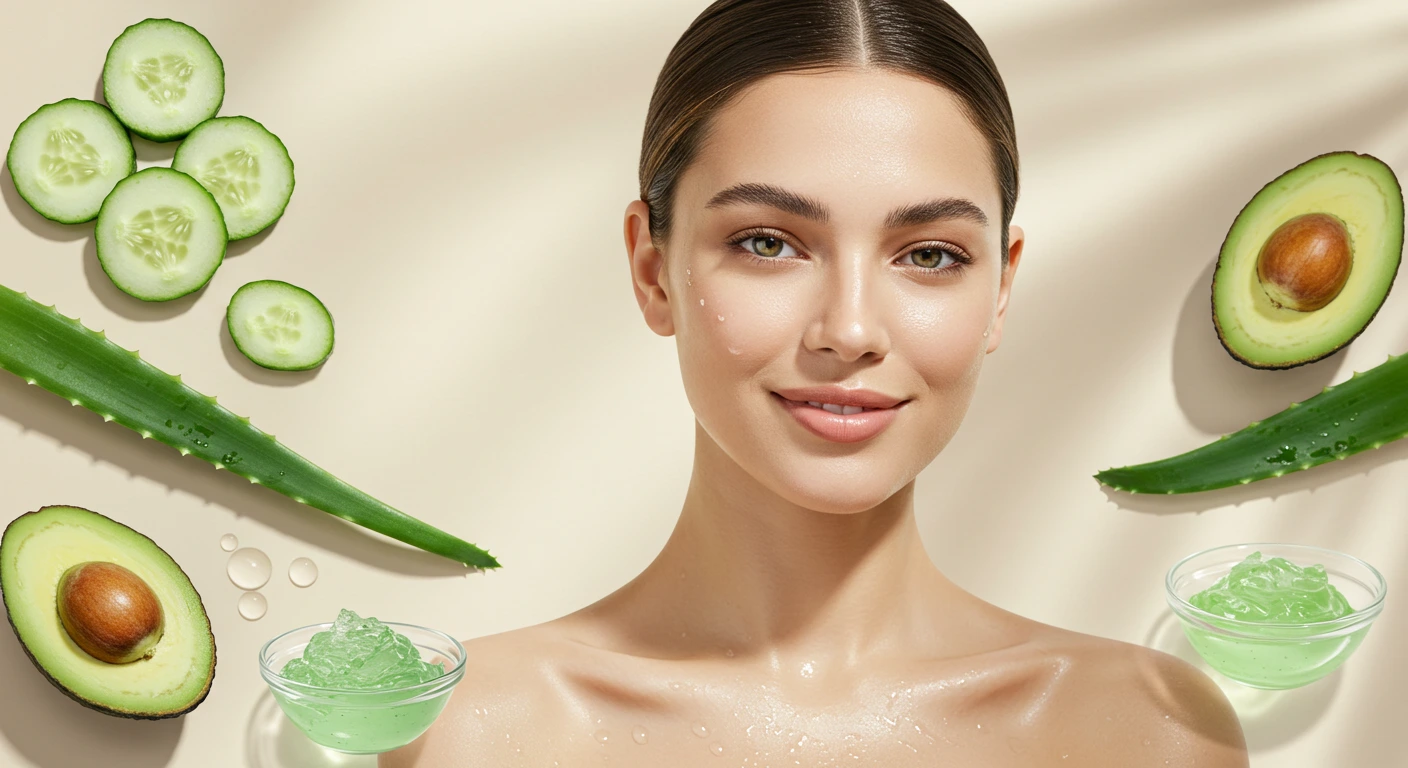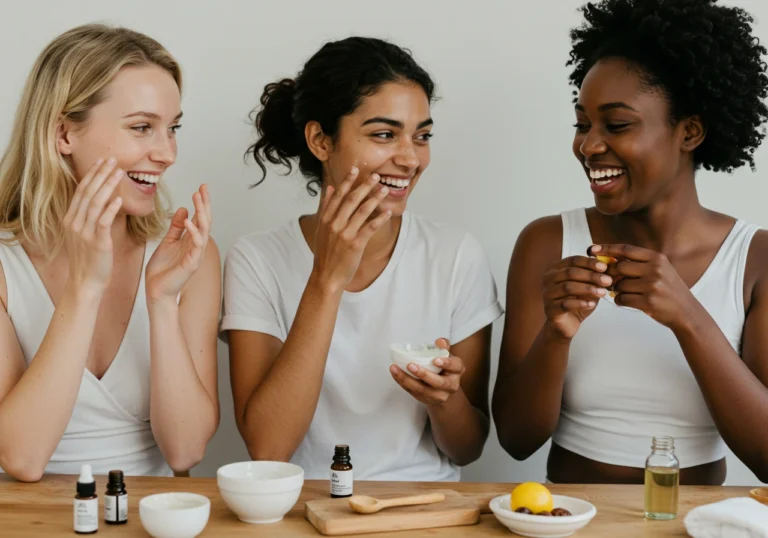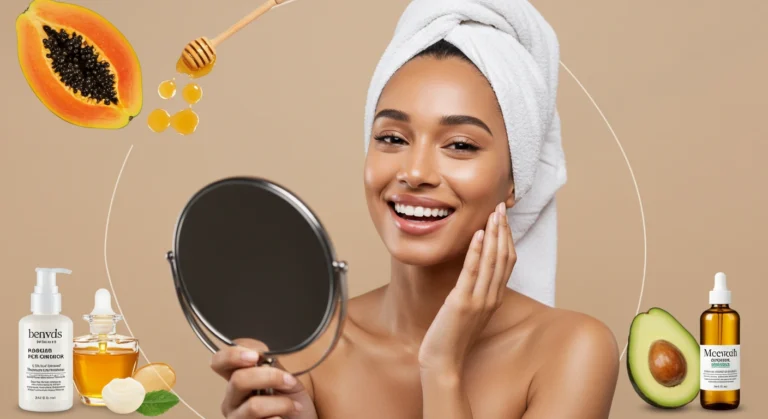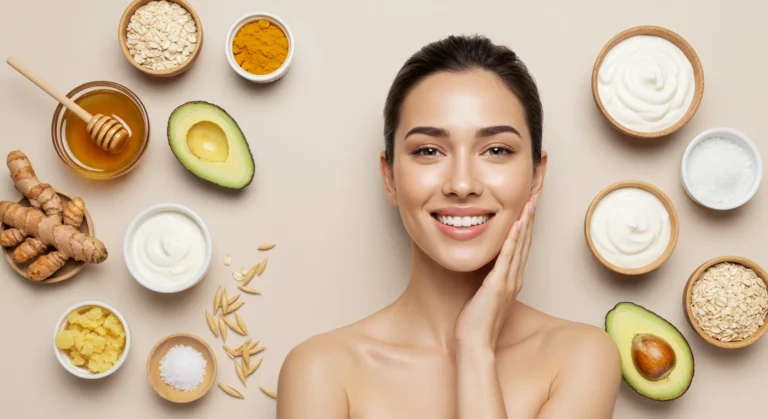Table of Contents
Tired of looking in the mirror only to see lackluster, dehydrated skin staring back at you? That persistent dullness can feel impossible to overcome, especially when you’re committed to using only plant-based, cruelty-free products. But there’s good news for conscious consumers seeking that coveted healthy glow.
My journey toward radiant vegan skincare began nearly a decade ago when I eliminated animal-derived ingredients from my beauty routine. After countless experiments and research into plant-based alternatives, I’ve developed a set of vegan hydration techniques that rival (and often surpass) their conventional counterparts.
In this comprehensive guide, you’ll discover seven powerful vegan skincare strategies that transform tired, thirsty skin into a luminous complexion. I’ll share the plant-powered ingredients that work wonders, step-by-step application methods, customization options for your specific skin concerns, and answers to the most common questions about vegan hydration approaches.
Why This Skincare Remedy Works
The beauty of vegan skincare lies in its remarkable ability to deliver results while honoring both your values and your skin‘s natural processes. These plant-based approaches stand out because they’re:
- Crafted with botanicals that mimic your skin’s natural moisture factors
- Rich in antioxidants that combat environmental stressors causing dullness
- Free from potential irritants found in animal-derived ingredients
- Sustainable and environmentally conscious while being genuinely effective
- Compatible with your skin‘s microbiome for lasting hydration
- Gentle enough for daily use without disrupting your skin barrier
Choosing the Right Ingredients

Top Ingredients for Skin Renewal
The foundation of effective vegan skincare is selecting powerhouse plant ingredients that address multiple aspects of skin hydration and radiance:
Hyaluronic Acid (Plant-Derived): This molecule holds up to 1000 times its weight in water and can be sourced from fermented wheat or soy. It works by drawing moisture into multiple layers of your skin, creating immediate plumping and lasting hydration.
Plant Oils Rich in Omega Fatty Acids: Avocado oil delivers deep nourishment with its penetrating fatty acids and vitamin E content. Argan oil restores elasticity while balancing sebum production. Evening primrose oil soothes inflammation while supporting your skin barrier.
Natural Humectants: Aloe vera provides instant hydration while delivering healing nutrients. Glycerin (vegetable-derived) pulls moisture from the environment into your skin. Cucumber extract offers hydration alongside gentle astringent properties.
Antioxidant-Rich Extracts: Green tea extract fights free radicals while providing anti-inflammatory benefits. Sea buckthorn oil is packed with rare omega-7 fatty acids that repair and protect. Pomegranate extract contains powerful polyphenols that strengthen skin against environmental damage.
What to Avoid
Even within the vegan skincare world, certain ingredients can exacerbate dullness rather than solve it:
- Alcohol denat or SD alcohol that strips your skin barrier
- Synthetic fragrances that trigger irritation and inflammation
- Mineral oil derivatives that create false hydration without benefits
- Harsh plant extracts like certain essential oils that disrupt your skin’s pH
- Drying clays when used too frequently or left on too long
- Harsh physical exfoliants that create micro-tears in sensitive skin
Substitutions
Creating versatile vegan skincare routines means knowing which plant ingredients can effectively replace others:
- Maple syrup or agave instead of honey for humectant properties
- Oat milk rather than dairy milk for gentle exfoliation and soothing
- Shea butter in place of beeswax for barrier protection
- Plant-based glycerin instead of animal-derived glycerin for moisture attraction
- Coconut yogurt rather than dairy yogurt for probiotic benefits
- Rice water instead of hydrolyzed animal proteins for amino acid support
Ingredients & Prep
Prep Essentials
Before applying any vegan treatment, proper preparation ensures maximum effectiveness:
- Cleanse with a pH-balanced vegan cleanser (look for coconut-derived surfactants)
- Gently exfoliate with enzyme-based products once weekly to remove dead skin cells
- Create a mini facial steam with a bowl of hot water and optional herbs like chamomile or lavender
- Always conduct a patch test on your inner wrist 24 hours before trying new ingredients
- Prepare all tools and ingredients before beginning to avoid interruptions during application
DIY Mask Ingredients
Basic Vegan Hydration Mask:
- 2 tablespoons fresh aloe vera gel (inner leaf)
- 1 teaspoon vegetable glycerin
- 5 drops jojoba oil
- Optional: 2 drops lavender essential oil (if not sensitive)
Overnight Moisture Restoration:
- 1 tablespoon mashed avocado
- 1 teaspoon argan oil
- 1/2 teaspoon maple syrup
- 1/4 teaspoon vitamin E oil (check for vegan sourcing)
Quick-Fix Glow Booster:
- 2 tablespoons cucumber juice
- 1 teaspoon powdered seaweed (kelp or spirulina)
- 1/2 teaspoon rice water
- Pinch of turmeric powder
Pantry Staples
Most effective vegan skincare treatments can be created using common plant-based ingredients:
- Extra virgin olive oil: Rich in squalene and antioxidants
- Oats: Anti-inflammatory and gently exfoliating when ground
- Coconut yogurt: Provides probiotics and gentle lactic acid
- Turmeric: Brightening and reduces inflammation
- Agave or maple syrup: Natural humectants
- Rice water: Amino acids and gentle brightening
- Green tea: Antioxidant-rich and soothing
Step-by-Step Application Instructions

Before You Begin
- Remove all makeup with a vegan oil cleanser or micellar water
- Cleanse with a gentle, sulfate-free vegan face wash
- Apply a warm (not hot) damp towel to your face for 1-2 minutes to open pores
- Pat skin until just slightly damp, not completely dry
- Prepare your chosen treatment in a clean glass or ceramic bowl
How to Apply
- Using clean fingertips or a facial mask brush, apply an even layer of your chosen vegan treatment to clean skin
- Start from the center of your face and work outward in gentle upward strokes
- Avoid the immediate eye area, nostrils, and lips
- Apply slightly thicker layers to especially dry areas like cheeks or forehead
- Leave on for the recommended time (typically 15-20 minutes for hydrating treatments)
- For overnight treatments, apply a thin layer and place a clean towel over your pillow
Rinse & Aftercare
- Rinse thoroughly with lukewarm water, never hot
- For oil-based treatments, use a soft bamboo cloth soaked in warm water to gently remove residue
- Pat (don’t rub) your face dry with a clean, soft towel
- Apply alcohol-free plant-based toner while skin is still slightly damp
- Follow immediately with plant oil-based serum and moisturizer to seal in hydration
- For daytime, finish with vegan mineral sunscreen (zinc oxide-based)
Pro Tips for Radiant Results
Avoiding Irritation
- Always conduct a patch test 24 hours before trying new plant ingredients
- Start with shorter application times (5-10 minutes) before working up to full duration
- If you experience tingling that progresses to burning, remove immediately
- Introduce new ingredients one at a time to identify potential sensitivities
- Remember that “natural” doesn’t automatically mean non-irritating – plant compounds can be potent
Recommended Tools
- Bamboo facial mask brush for sustainable, even application
- Glass mixing bowls instead of plastic (more hygienic and environmentally friendly)
- Measuring spoons dedicated to skincare use
- Organic cotton or bamboo reusable facial rounds for application and removal
- Clean muslin cloths for gentle removal of treatments
- Small glass jars with airtight lids for storage
Storage & Reuse
- Refrigerate freshly made vegan treatments in airtight glass containers
- Most fresh preparations will keep 3-5 days when properly refrigerated
- Freeze aloe vera in ice cube trays for single-application portions
- Add a drop of vitamin E oil to extend shelf life slightly
- Label all containers with ingredients and preparation date
- Discard any preparation that changes color, texture, or develops an off smell
Custom Variations
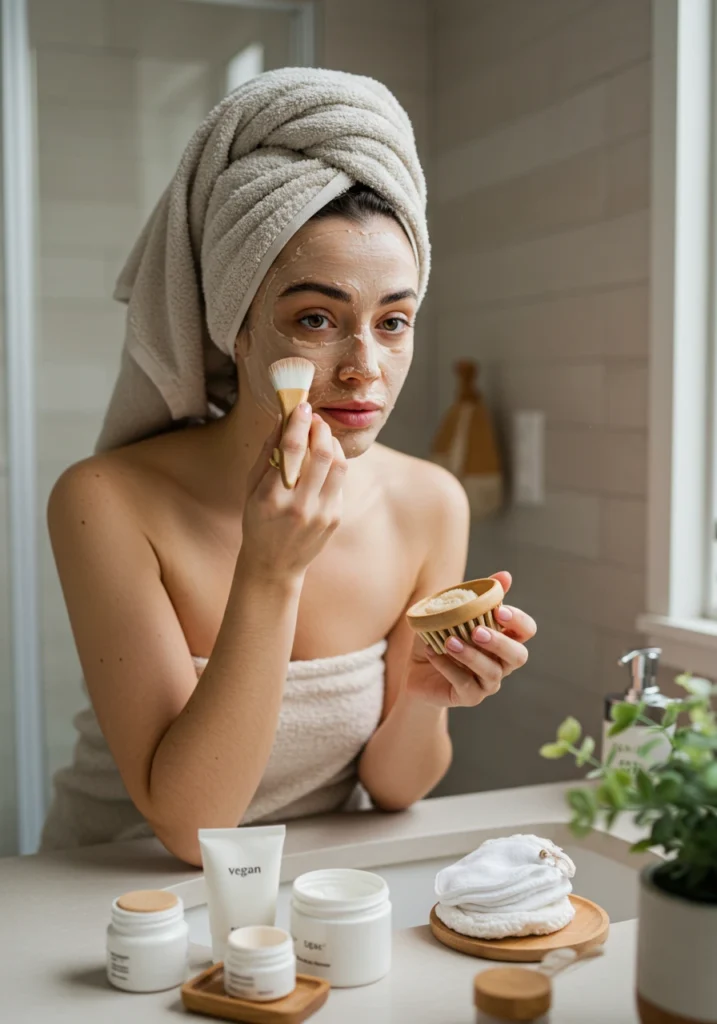
For Dryness
Transform any base mask into an intensive moisture treatment with these modifications:
- Add 1/4 teaspoon of avocado oil for lipid replenishment
- Incorporate a few drops of sea buckthorn oil for omega fatty acids
- Replace water with coconut milk for richer hydration
- Add 1/2 teaspoon of shea butter (melted) for barrier protection
- Follow with a few drops of argan oil pressed into the skin after treatment
For Excess Oil
Balance your skin’s sebum production without stripping with these adjustments:
- Add 1/2 teaspoon of French green clay (not bentonite, which can be too drying)
- Use green tea as your liquid base instead of water
- Incorporate willow bark extract for natural BHA content
- Add a few drops of non-comedogenic jojoba oil to regulate sebum
- Follow with an alcohol-free witch hazel and aloe toner
For Sensitivity
Create gentler versions of vegan treatments with these modifications:
- Use colloidal oatmeal as a soothing base ingredient
- Replace potential allergens like nut oils with seed oils (sunflower, safflower)
- Add a teaspoon of cucumber juice for cooling properties
- Include a small amount of calendula-infused oil for healing
- Reduce all active ingredients by half for the first few applications
- Avoid all essential oils completely
Best Times to Use This Remedy
Routine Placement
For maximum hydration benefits, timing matters when incorporating vegan treatments:
- Apply intensive hydrating masks after cleansing and toning, but before serums and oils
- Use overnight treatments as the final step of your evening routine
- Quick-fix masks work well in the morning before makeup application (allow 15 minutes to absorb)
- Mist-based hydrators can be used throughout the day over makeup
- Layer treatments from thinnest to thickest consistency for optimal absorption
Suggested Frequency
Consistency with appropriate frequency delivers the best results:
- Hydrating vegan masks: 2-3 times weekly
- Overnight treatments: 1-2 times weekly
- Quick moisture boosts: Daily if needed
- Intensive treatments: Once weekly, especially during seasonal transitions
- Adjust frequency higher during winter or in dry climates
- Reduce frequency if using other active treatments like retinol or acids
Pre-Event Boost
For special occasions when you want an extra radiant appearance:
- Begin hydration-focused treatments 3-4 days before an event
- Apply a thin layer of overnight treatment the evening before
- Use a quick-absorbing hydration mask 3 hours before the event
- Follow with a lightweight moisturizer that works well under makeup
- Bring a plant-based facial mist for touch-ups throughout the event
FAQs
Is vegan skincare suitable for sensitive skin?
Yes, many vegan ingredients are particularly well-suited for sensitive skin as they avoid common animal-derived allergens like lanolin and beeswax. However, plant ingredients can still cause reactions in some individuals. Always patch test and start with the gentlest formulations. Fragrance-free options with minimal ingredients are best for reactive skin.
How often can I apply these vegan hydrating treatments?
For most skin types, hydrating masks can be used 2-3 times weekly, while overnight treatments should be limited to 1-2 times per week. Daily use of lightweight hydrators is generally fine. Always monitor your skin’s response and adjust frequency as needed—more isn’t always better, even with gentle ingredients.
Can I combine these vegan treatments with active ingredients like retinol or vitamin C?
Yes, but timing matters. Use hydrating vegan treatments on alternate nights from retinol, or apply them in the morning if you use retinol at night. For vitamin C, wait 15-20 minutes after application before applying hydrating treatments. Always ensure your skin barrier is healthy before combining multiple active ingredients.
How do I know if a product is truly vegan?
Look for official certifications like the Vegan Society’s Vegan Trademark or PETA’s bunny logo. For DIY ingredients, research each component carefully—some surprising ingredients like carmine (from beetles) or shellac may appear in “natural” products. When in doubt, contact manufacturers directly about their ingredients and testing policies.
Will these vegan treatments help with fine lines as well as hydration?
While these treatments primarily target hydration, increased moisture levels do temporarily plump the skin, making fine lines less visible. For longer-term anti-aging benefits, look specifically for vegan ingredients with proven benefits such as bakuchiol (plant alternative to retinol), vitamin C from plant sources, and peptides derived from rice or soy.
Are these vegan treatments environmentally sustainable?
Most plant-based ingredients in these treatments have a lower environmental impact than animal-derived alternatives. However, sustainability varies by source and production method. Choose organic when possible, opt for locally sourced ingredients to reduce carbon footprint, and select ingredients that don’t contribute to deforestation (like certain palm oil sources).
How soon will I see results from these vegan hydrating treatments?
Immediate hydration benefits are typically visible after the first application, with skin appearing plumper and more radiant. For deeper improvements in skin texture and persistent dryness, consistent use over 4-6 weeks will show more substantial results. Patience and consistency are key elements of any effective skincare approach.
Conclusion
Achieving hydrated, radiant skin with entirely vegan ingredients isn’t just possible—it’s preferable for many skin types. The seven tips shared in this guide harness nature’s most effective hydrators without compromising on ethical values or results.
By incorporating these plant-powered strategies into your regular skincare routine, you’ll likely notice not only immediate improvements in hydration but also long-term benefits in skin texture, resilience, and natural luminosity. The beauty of vegan skincare lies in its ability to work with your skin’s inherent processes rather than forcing temporary results.
This approach to hydrating dull skin naturally has become a go-to for those seeking sustainable beauty solutions that don’t sacrifice performance. Our community of conscious skincare enthusiasts continues to report transformative results, particularly during seasonal transitions when skin needs extra support.
Ready to experience the difference plant-based hydration can make? Begin with our Intensive Moisture Reset Mask and then explore our complete collection of Plant-Powered Glow Essentials for your daily vegan skincare ritual.

